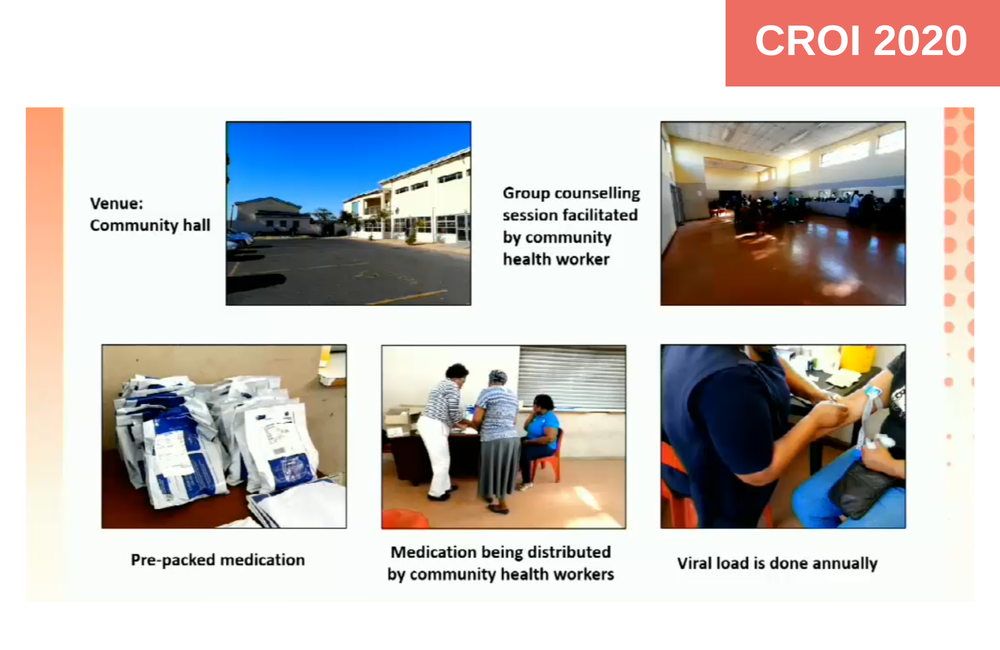
Adherence clubs were linked to a 30% reduction in high viral load among postpartum South African women living with HIV, the Conference on Retroviruses and Opportunistic Infections (CROI 2020) heard last week.
Dr Jasantha Odayar of the University of Cape Town, South Africa presented these findings from a randomised controlled trial on behalf of the Postpartum Adherence Clubs for Antiretroviral Therapy (PACART) study team.
Background
The World Health Organization recommends starting lifelong antiretroviral therapy (ART) in all pregnant women living with HIV (Option B+). Despite the dramatic reduction in mother-to-child transmission rates in South Africa since its adoption in 2013, non-adherence and/or high rates of disengagement from care are common among postpartum women and afterwards. The consequence for many will be increased risk of virologic failure, disease and death.
Adherence clubs and other models of differentiated service delivery are used increasingly to deliver ART in high burden settings. Few data exist on models for postpartum women.
Since 2011 the community-based adherence club model has been widely implemented in Cape Town, South Africa. In the adherence clubs, groups of 20 to 30 people meet every two to four months for ART dispensing at a community hall. Community health workers, supported by nurses, run these decentralised services.
Observational evidence suggests stable general adult patients managed through adherence clubs have a reduced risk of loss to follow-up compared to those attending routine clinic services. A study showed similar virologic outcomes among postpartum women six months after delivery managed in adherence clubs compared to those in routine clinic services.
There is an urgent need for evidence-based approaches to support mothers beyond pregnancy and delivery, Dr Odayar said.
Adherence clubs compared to standard of care
The authors evaluated adherence clubs to deliver long-term HIV care to postpartum women who started ART in pregnancy at the Gugulethu Community Health Centre and the associated Midwife Obstetric Unit in Cape Town.
This public sector primary care facility serves a population of around 350,000, most of low socioeconomic status. The Centre includes an ART clinic providing HIV care to the general adult population. The Obstetric Unit provides services to over 4000 women each year. Antenatal care coverage is high (95%) as is antenatal HIV prevalence (30% in 2016).
From 2016 to 2017 consecutive postpartum women who started ART (tenofovir+emtricitabine+efavirenz) seeking care at this primary care antenatal clinic were randomised to either the local ART clinic (standard of care) or the community-based ART adherence club (intervention). Women attended a general adherence club rather than a specific club for postpartum women. Eligibility included being clinically stable with a viral load under 400 and on ART for more than six months.
Adherence club visits typically take an hour whereas an ART clinic visit can take most of the day. They are led by lay health workers rather than a nurse or doctor.
The primary objective was to compare maternal HIV viral suppression up to 24 months postpartum.
A total of 412 women were randomised at a median of 10 (6-20) days postpartum, with a median age of 27 years at enrolment. The median time on ART before giving birth was 164 days (a little under six months). All the women had a viral load below 1000, while 87% had one under 50.
Seventy-seven per cent of women attended the adherence club within three months of referral compared to 68% the ART clinic. The majority (90%) completed the final visit 24 months postpartum with no differences between arms.
At 12 months, 16% and 23% of women in the adherence club and ART clinic arms respectively had ever had a viral load over 1000. At 24 months this was 29% and 37%, respectively (hazard ratio = 0.71 (95% CI: 0.50-1.01, p = 0.056)).
Viral load over 50 at 24 months was 44% and 56% in the adherence clubs and ART clinic, respectively (hazard ratio = 0.69 (95% CI: 0.52-0.92, p = 0.009)).
Maternal and infant outcomes (such as TB, mortality and infant testing) were similar across arms. There was no mother-to-child transmission of HIV.
Dr Odayar concluded adherence clubs have the potential to be an important intervention to improve women’s virologic outcomes. As a well-established system to which postpartum women were already being referred, it did not require additional resources or expertise, she added.
Odayar J et al. Differentiated care for postpartum ART in South African women living with HIV: a RCT. Conference on Retroviruses and Opportunistic Infections, abstract 131LB, March 2020.
